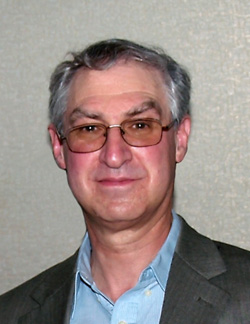MED Prof Nabs NIH Award for Heart Mending
Lehman given fast-track funding for cardiac muscle research

Out-of-sight, and for most of us out-of-mind, muscles pump blood from our heart thousands of times a day. For more than three decades, William Lehman, a School of Medicine professor of physiology and biophysics, has been peering ever closer at these cardiac muscles, trying to learn how they work on a molecular level, and by extension, how they don’t work when the heart is diseased.
Last month, the National Heart, Lung, and Blood Institute, part of the National Institutes of Health (NIH), rewarded his dedication with a MERIT (Method to Extend Research in Time) award, giving him up to 10 years of research support, compared to the 3 to 5 years of funding that NIH typically grants.
“The MERIT award is designed to provide long-term stable support to investigators whose research competence, productivity, and scientific contributions are distinctly superior, and who are likely to continue to perform in an outstanding manner,” according to the letter announcing Lehman’s award. It’s a rare honor, says Karen Antman, dean of MED and provost of the Medical Campus, who describes the NIH designation as “a really big deal.”
Lehman also studies the workings of skeletal muscle, which is primarily responsible for voluntary body movement, and smooth muscle, which controls the body’s hollow organs, such as the bladder and the gastrointestinal tract. But it was his cardiac muscle research that led to the MERIT award. Specifically, Lehman is investigating how certain proteins turn muscles on and off.
When a muscle contracts, two types of muscle filaments — thick and thin — slide past one another, shortening the tissue. The thick filaments have what Lehman describes as cross-bridges that attach and detach their way along a molecular track of the protein actin, which is contained in the thin filaments. Two other proteins — troponin and tropomyosin — can either help the cross-bridges bind to the thin filament or prevent the bond and switch the muscle to “off” by blocking the receptor sites.
“We know, in general, what this sliding mechanism involves. We know what protein components are needed for the muscle’s on/off switch to work,” says Lehman. “But we don’t know what the molecular mechanics of it are, the changes in protein shape and position that allow this switch to work.”
To find out, Lehman uses electron microscopes to take high-resolution images of a single layer of muscle thin filaments, which a computer transforms into a three-dimensional image, allowing the researchers to observe the changes in shape and position of actin and the other proteins.
“His research is key in deciphering the cardiovascular disease process,” explains Winnie Barouch, the NHLBI program director who oversees Lehman’s grants. Ultimately, such knowledge could aid in the development of targeted drug therapies for these diseases.
“We’re now at a stage where we can manipulate the system. We can add mutant forms of a protein and see how dysfunction might arise,” says Lehman, who often collaborates in this research with Roger Craig, a professor of cell biology at the University of Massachusetts Medical School, and Larry Tobacman, a professor of medicine, physiology, and biophysics at the University of Illinois.
The MERIT award will provide stable funding that will enable the researchers to look closer at the muscle filaments. “Right now, we can already see the gross shape of molecules,” Lehman says, “but we can’t see the individual amino acids, let alone how they interact with each other.”
Chris Berdik can be reached at cberdik@bu.edu.
Comments & Discussion
Boston University moderates comments to facilitate an informed, substantive, civil conversation. Abusive, profane, self-promotional, misleading, incoherent or off-topic comments will be rejected. Moderators are staffed during regular business hours (EST) and can only accept comments written in English. Statistics or facts must include a citation or a link to the citation.